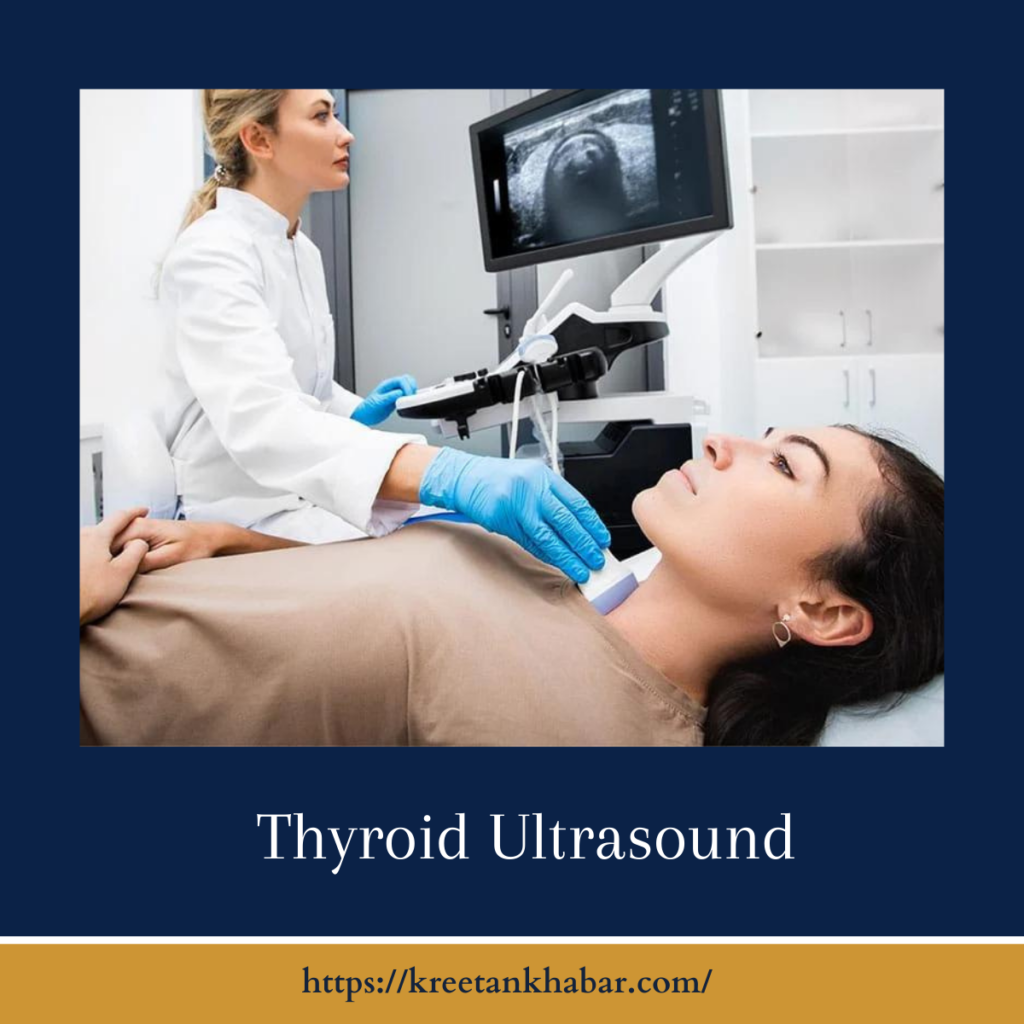Thyroid Ultrasound
Introduction:
Thyroid health is pivotal for overall well-being, and when concerns arise, diagnostic tools like thyroid ultrasound play a crucial role in unveiling the intricacies of this small but mighty gland. A thyroid ultrasound is a non-invasive imaging technique that employs sound waves to capture detailed images of the thyroid gland. In this article, we will delve into the purpose, procedure, and significance of thyroid ultrasound in understanding and managing thyroid-related conditions.

Understanding Thyroid Ultrasound:
A thyroid ultrasound is a diagnostic imaging procedure that provides a detailed view of the thyroid gland, a butterfly-shaped organ located at the base of the neck. It is primarily utilized to evaluate the size, structure, and potential abnormalities of the thyroid, including nodules, cysts, or inflammation. Unlike other imaging methods, such as CT scans or X-rays, ultrasound does not involve ionizing radiation, making it a safe and effective tool for repeated use in monitoring thyroid health.
Purposes of Thyroid Ultrasound:
The purposes of thyroid ultrasound extend far beyond mere imaging, encompassing a range of essential roles in thyroid health assessment. One primary objective is the detection and characterization of thyroid nodules. As these nodules are common and often benign, ultrasound aids in determining their size, composition, and characteristics, guiding healthcare professionals in deciding whether further investigation or biopsy is necessary. Additionally, thyroid ultrasound serves as a valuable tool for evaluating the overall structure and function of the thyroid gland.
This comprehensive insight assists healthcare providers in assessing thyroid health and its potential impact on hormone production, enabling them to tailor treatment plans to individual patients. Furthermore, in cases where suspicious nodules are identified, thyroid ultrasound plays a pivotal role in guiding fine-needle aspiration biopsy procedures, contributing to the accurate diagnosis of nodules and facilitating timely intervention when needed. The multi-faceted purposes of thyroid ultrasound underscore its significance as a versatile and indispensable tool in the realm of thyroid health diagnostics.
- Nodule Detection: Thyroid nodules are common, and while the majority are benign, ultrasound helps identify their presence, size, and characteristics. This information aids in determining the need for further investigation or biopsy.
- Evaluation of Thyroid Function: Thyroid ultrasound provides valuable insights into the overall structure and function of the thyroid gland, assisting healthcare professionals in assessing its health and potential impact on hormone production.
- Guidance for Biopsy: In cases where suspicious nodules are identified, ultrasound serves as a guidance tool for fine-needle aspiration biopsy. This minimally invasive procedure helps in determining the nature of the nodule, whether benign or malignant.
Procedure and Significance:
During a thyroid ultrasound, the patient lies on their back with the neck slightly extended. A water-based gel is applied to the skin, facilitating the smooth movement of the ultrasound transducer. The transducer emits high-frequency sound waves that bounce off the thyroid tissue, creating real-time images on a computer screen. The procedure is painless and typically takes around 15 to 30 minutes.
Thyroid ultrasound is significant for several reasons:
- Early Detection: By visualizing the thyroid in detail, ultrasound allows for the early detection of abnormalities, enabling prompt intervention and management.
- Non-Invasive Monitoring: It provides a non-invasive means of monitoring thyroid health over time, particularly in patients with pre-existing thyroid conditions or those undergoing thyroid treatment.
- Customized Treatment Plans: The insights gained from thyroid ultrasound contribute to the development of personalized treatment plans, ensuring that interventions align with the specific characteristics of the thyroid condition.
- Risk Stratification: Identifying and characterizing thyroid nodules through ultrasound assists in risk stratification, guiding healthcare providers in determining the appropriate level of follow-up or intervention required.
Conclusion:
Thyroid ultrasound stands as a valuable diagnostic tool in the realm of thyroid health, offering a non-invasive, detailed look into the structure and function of this essential gland. Whether for routine monitoring, early detection of abnormalities, or guidance in biopsy procedures, thyroid ultrasound plays a pivotal role in empowering healthcare professionals and patients alike to make informed decisions about thyroid health and overall well-being. Regular screenings and consultations with healthcare providers ensure the continued health and vitality of this small yet indispensable gland.
Read also : Exploring the Delightful Boost of the Green Tea Shot 2023